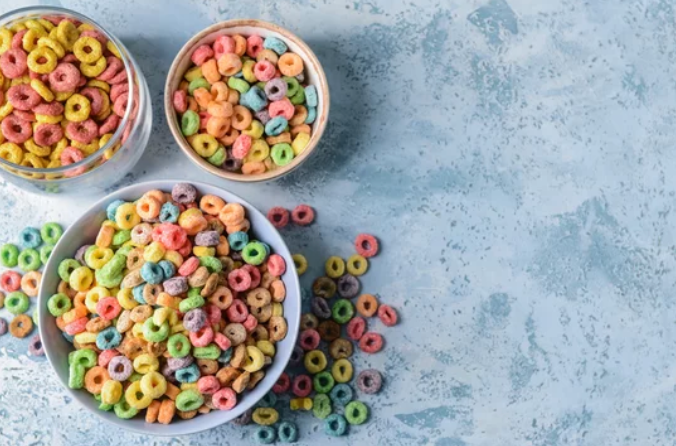RFK Jr. Announces FDA Plan to Ban Red Dye No. 40 Found in M&Ms, Lucky Charms
The FDA plans to phase out all eight petroleum-based artificial food dyes, including Citrus Red No. 2, Red No. 4, Red No. 40, Green No. 3, Yellow No. 5, Blue No. 1, Blue No. 2 and Orange B.
By
Chelsie Derman
| Published on April 24, 2025
5 min read
Credit: Pixel-Shot

Secretary of Health and Human Services (HHS) Robert F. Kennedy Jr. announced Tuesday that the HHS department and the Food and Drug Administration (FDA) will phase out all eight petroleum-based artificial food dyes from the nation’s food supply — including Red No. 40 — by the end of next year.
These dyes show up in everything from M&M’s and Lucky Charms to Tylenol PM and frosted strawberry Pop-Tarts. That means some of your favorite snacks and cereals may soon lose their bright hues.
Back in January, the Biden administration announced the ban of Red No. 3, linked to cancer in rats, which must be removed from food by 2027 and from medications by 2028. The HHS and the FDA stated on Tuesday that they are requesting food companies pull Red No. 3 ahead of the 2027-28 deadline.
The agencies also plan to ban two other synthetic food dyes in the coming months: Citrus Red No. 2 (used on Florida orange peels) and Orange B (in hot dog and sausage casings or surfaces).
Federal health agencies are planning to eliminate the other six petroleum-based dyes by the end of 2026: Green No. 3 (canned vegetables, ice cream, Jello, salad dressings, ibuprofen, Colgate mouthwashes), Red No. 40 (Swedish Fish, Welch's fruit snacks, strawberry milk), Yellow No. 5 (Lucky Charms, M&Ms, Skittles, yellow cake mix, Mountain Dew, Doritos), Yellow No. 6 (Trix, Froot Loops, Fanta Soda), Blue No. 1 (M&Ms, Airheads, Jolly Ranchers, Pillsbury Funfetti Aqua Blue Vanilla Flavored Frosting, Prozac), and Blue No. 2 (Pillsbury aqua blue frosting, soaps, shampoos, some dog foods).
This list doesn’t even scratch the surface of all the food with synthetic dyes. Even with all the dyes out there, red dye No. 4 stands as the most common synthetic food dye in the U.S. and Canada food supply.
The FDA and European Food Safety Authority regulators both agree Red No. 40 is safe in small quantities — no more than 7 milligrams per kilogram per day. As a registered dietitian explained to Yahoo Life, someone who weighs 154 pounds could theoretically consume up to 490 milligrams of red dye No. 40 daily without adverse effects.
With the synthetic food dye ban, companies will have to explore natural food coloring, such as curcumin, carotenes, paprika and anthocyanins. However, it isn’t that simple, as these natural dyes are less colorful, more costly to produce and have a shorter shelf life. These disadvantages may make the product less desirable to consumers.
This isn’t just food. Synthetic food dyes are put in children’s medication to make it more appealing. However, making the medication more attractive may bring harm to children.
Research suggests a link between synthetic food dyes and behavioral issues in children. A report published by the California Office of Environmental Health Hazard Assessment in 2021 found that synthetic food dyes are linked to hyperactivity and neurobehavioral problems in children.
Red dye No. 40 also causes behavioral disruptions and contains benzene, an ingredient correlated with cancer. The dyes Blue No. 1 or Yellow No. 5 are generally safe within regulatory limits but can lead to allergic reactions or behavioral issues.
Some big brands are already responding. A memo from the Consumer Brand Association (which includes PepsiCo and General Mills) said members are ready to remove these dyes, with their two-page proposal stating their efforts within 30 days. The memo left out an explicit commitment to remove the dyes by the end of 2026, as Kennedy wanted.
The proposal also stated their commitment to take out artificial dyes in school lunches. Already, West Virginia and California have passed laws to ban several food dyes from school lunches, which will go into effect in August and 2028, respectively.
At a news conference surrounded by “Make America Healthy Again” supporters, Kennedy said the FDA and HHS will work with food companies to remove dyes from products.
“Four years from now, we're going to have most of these products off the market, or you will know about them when you go to the grocery store,” he said.

